The works of Sossy Dikijian
PRAXIS OF CHANGE
An exhibition of works by various artists
22 September – 30 November 2021
Firetti Contemporary, Dubai
Designed to inspire artistic appreciation and a desire to respond to environmental challenges, the goal of the exhibition is to view art through ecological glasses: How the environment is represented within images and sculptures as well as how the role of humans on Earth is depicted.
There’s a crescendo of interest in both art that is itself in connection with the environment and art that is self-consciously environmental, ultimately drawing attention to anthropogenic global warming. The dialogue between art and our ecological systems surface, where the interconnection of humans and nature can be observed.
Born from the tenacity and hunger to engage with various audiences, the exhibition aims in bringing individuals together outside political affiliation and dive into a different world that allows for more empathy. In conjunction with this passion and desire from artists who grapple with the immensity of environmental degradation, Praxis of Change brings forth the amalgamation of these ideas.
The exhibition is a manifesto stating that saving the planet is a collective effort as well as it demands individual responsibility. Where you are right now and with what you have, there are choices you can make to do your part to save the planet. This is a subject which can be impacted by every single person on Earth. We need to start changing the way we live and focus on a life which aims to help the climate fight, rather than battling against it.
Praxis of Change provides a visual and perceptive insight into the realm of sustainable actions. The impact of intrinsic values is reflected through the well-being of our environment, shedding light on the critical need for a paradigm shift in our current reality. The event falls inline with the core values of Expo 2020 – Connecting Minds and Creating the Future’ through sustainability, mobility and opportunity.
The exhibition showcases the works of 10 different artists, a number that invites a countdown to action and challenges the viewers to implement 10 initiatives towards a more sustainable way of living.
The artists taking part in this exhibition include Charbel Samuel Aoun (Lebanon), Catherine Latson (USA), Laura Lappi (Finland), Rachel Libeskind (USA), Irvin Pascal (UK), Ghizlane Sahli (Morocco), Arjan Shehaj (Albania), Collin Sekajugo (Uganda), Eltjon Valle (Albania) and Fatiha Zemmouri (Morocco)
Helidon Xhixha, IMPRINT
22 March – 20 May 2021
Firetti Contemporary, Dubai
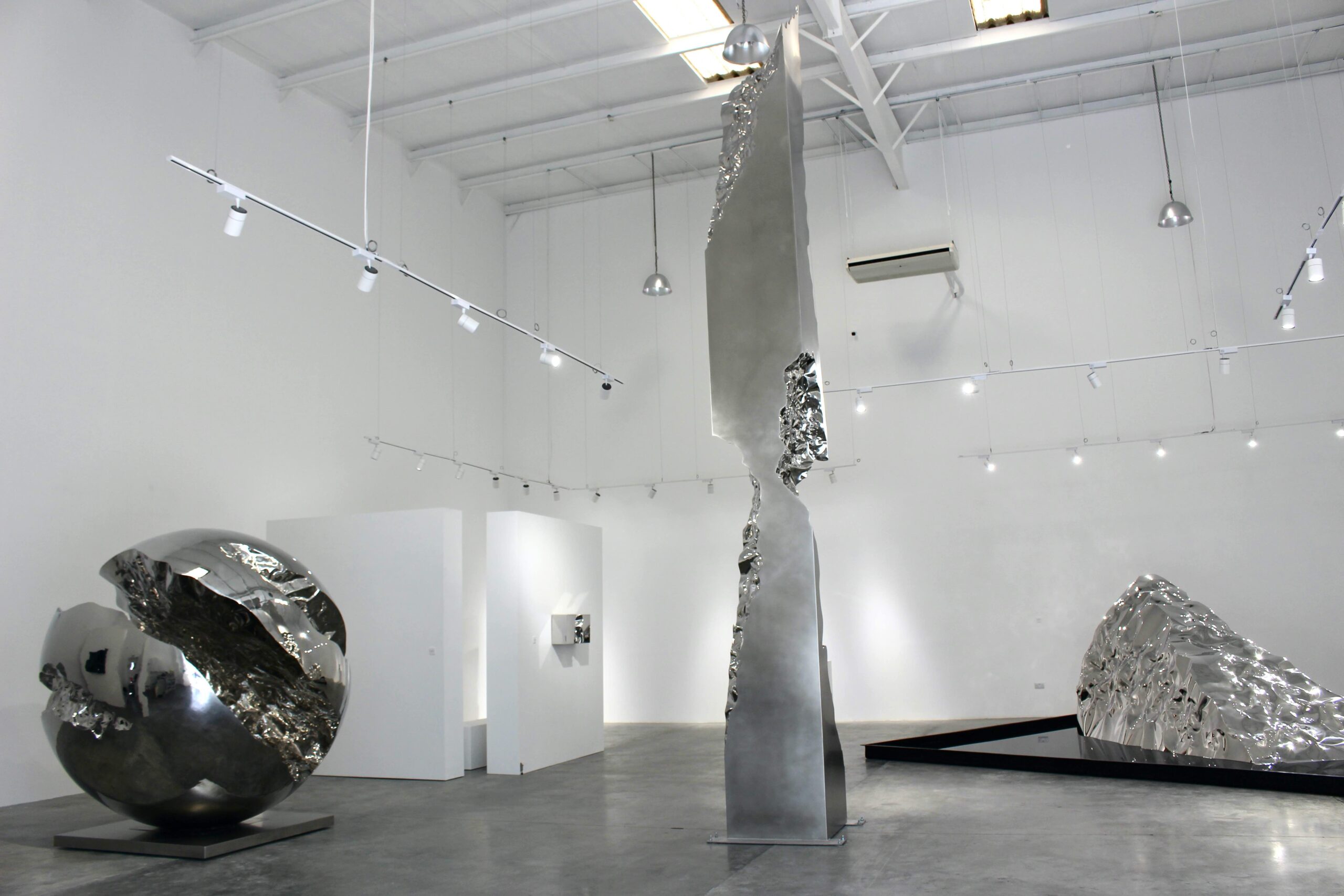
Firetti Contemporary presents a solo exhibition of monumental artworks by international sculptor Helidon Xhixha in occasion of its first opening show.
Two stainless steel sculptures entitled Iceberg and Earth are at the center of the exhibition standing as an astounding manifesto in support of the awareness of Global Warming and the melting of polar glaciers.
An artist whose sculptural practice has gone from strength to strength – Helidon Xhixha’s Iceberg installations convey the intense sense of wonder that characterize his outlook and attitude towards art.
With an approach that is the result of an artistic upbringing, a formal education and the artist’s own instinctive, creative drive, Xhixha presents us with a grand spectacle: Art which challenges its audience. Not simply through its sheer scale and mass but through its engagement with ideas of fundamental importance.
The floating installation ICEBERG by Helidon Xhixha was first exhibited in the middle of the Venetian lagoon in occasion of the 56th Venice Biennale in 2015. A four meter high stainless steel sculpture, captivated audiences, garnering much attention from industry professionals and the media alike; as it floated through the Canal Grande and the Venetian lagoon.
This outstanding reflective sculpture made a statement for global warming and the potential impact it could have on a place such as Venice in the near future.
Luluwah Al Homoud, Beyond the Grid
30 April – 28 June 2018
Tabari Artspace, Dubai
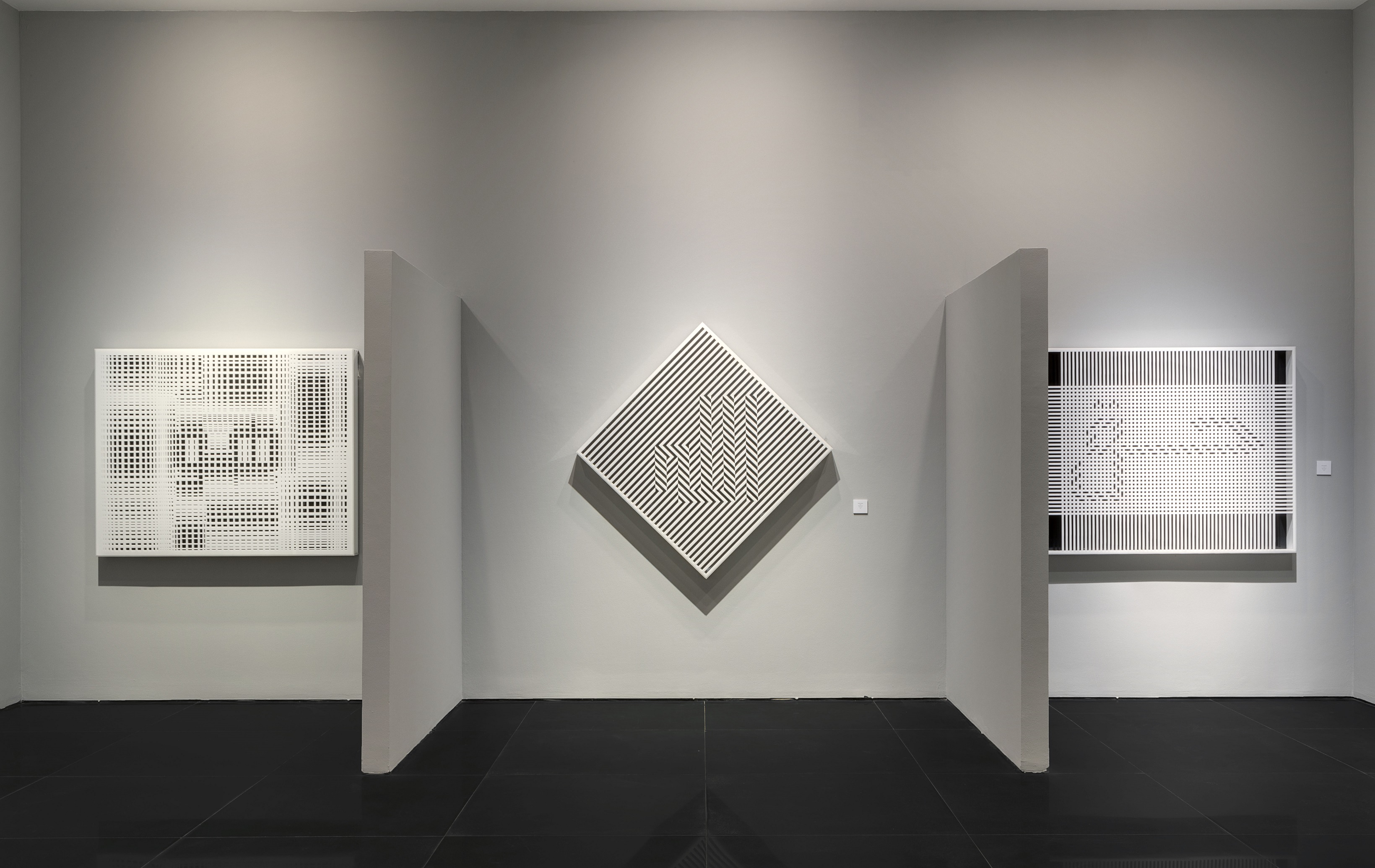
Beyond The Grid by London-based Saudi Arabian artist Lulwah Al Homoud, is composed of a selection of abstract artworks which draw influence from traditional Islamic art, synthesising its characteristic motifs with the regular rhythms of calligraphy and geometry, and ultimately deconstructing them to create a new visual vocabulary.
Amongst the works in the exhibition will be several large-scale minimalist pieces that emulate the geometric forms of Optical Art in bold, singular colouring. Alongside these larger works, Tabari Artspace will show 50 silkscreens from Al Homoud‘s series 99 names of God, displayed as limited-edition bound books.
The works, which originated from the artist’s fascination with written language and Arabic calligraphy, demonstrate a drive to break the rules of traditional Islamic geometric designs in order to create new codes where pattern and word become one.
Al Homoud’s work departs from the idea of numbers representing letters, and the Vedic square, a multiplication system based on a 9×9 grid first developed in North India. In her 9×9 works, Al Homoud incorporates this into her artwork but, instead of the traditional numeric use of 1-9, Homoud has used the first nine stages of the creation of man.
By joining the repeating numbers in the grid, a series of patterns begin to form from which Al Homoud creates her designs, going from multiplicity to unity by using the laws of proportion practiced in traditional Arabic calligraphy. Al Homoud employs a mixture of Islamic and Western mathematics to deconstruct arabic letters and create new codes to compose the 99 names of God, and create a series of new and visually exciting patterns.
As we engage in the dichotomies of existence, the rhetoric between substance, essence and fate compels us into asking what is abstract, what is solid, what is common and what is particular. This discourse moves back and forth between the humanities and the sciences, constantly shedding and reconstructing subtle layers. Arguably, what is most incongruous in this discourse is what is most convergent within it: communication. Using a pure language, this work locks together geometry, faith and beauty, pushing the boundaries of what we know, how we know it and how it is perceived. Lulwah Al Homoud
About Lulwah Al Homoud
Born in Riyadh, Saudi Arabia, Lulwah Al Homoud is based in the United Arab Emirates and London, UK.
Al Homoud completed an MA in Communication Design with a focus on Islamic Art at Central Saint Martins College of Art and Design.
Fascinated by the geometric intricacies of calligraphy, she trained under renowned Pakistani calligrapher Rasheed Butt. Calligraphy is central to Al Homoud’s work, which explores the complexities of linguistic, mathematical and visual systems of communication. Her artistic practice deconstructs Arabic script and applies ancient mathematical principles to devise unique systems of expression, revealed through the elaborate geometric patterns that have become a hallmark of her work. This process reflects Al Homoud’s preoccupation with the relationship between creator and creation, as well as the multifarious ways in which God communicates with man.
Al Homoud is an influential figure in Saudi Arabia, designing the logo and 118 calligraphic wall panels for the Saudi Arabian pavilion at the World Expo in Shanghai, China in 2010. Her work is in collections in international museums including the Los Angeles County Museum of Art (LACMA) in the US, Museum Five Continents in Germany and Jeju Museum in South Korea.
Solo exhibitions include The Dot, Sharjah Art Museum, UAE (2016); Sublime, Naila Art Gallery, Riyadh, Saudi Arabia (2016); Islamic Art Festival, Sharjah Art Museum, UAE (2015); Perpetual Codes, Sharjah Calligraphy Museum (2015); 9×9, Art Space Gallery, Dubai (2014); Ontology, Al Riwaq Art Space, Bahrain (2013).
Khaled Zaki, Resurrection
19 March – 25 April 2018
Tabari Artspace, Dubai
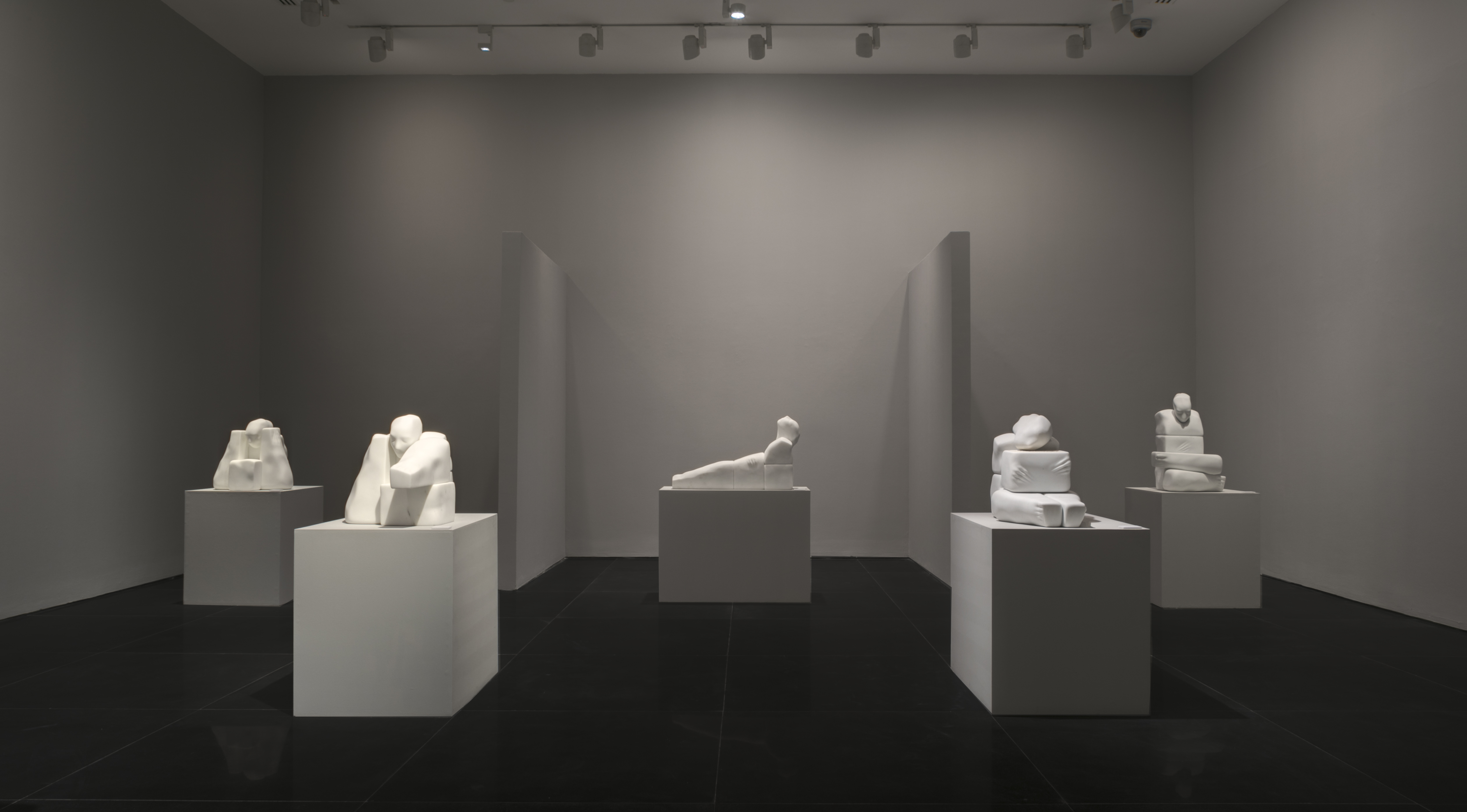
In the exhibition, the artist seeks to capture the essence of his subjects with minimal formal elements, while retaining the integrity of pure white marble. This ethereal colouring suggests a blank canvas from which we may rebuild and start afresh. Each of the sculptures consists of six separate marble components arranged in varying compositions to represent figures in states of fear, defensiveness or repose. The resulting works seem simultaneously modern and ancient, seeking to illicit a diverse emotional response born from the artist’s investigation of the infinite possibilities of the natural form.
Inspired by the fragments of buildings and shrapnel littering the streets in the aftermath of the Egyptian Revolution of 2011 and the Egyptian protests of 2013 as well as the ongoing unsettlement across Egypt, Afghanistan, Iraq and Syria, the artist attempts to symbolically rebuild crumbled societies; to restore order and shape a better future. This is encompassed by the titular concept of rebirth.
Currently based between Cairo and Tuscany, Zaki was born in Suez, Egypt (b. 1964) and has been a key contributor to the development of modernism in Egypt during the second part of the twentieth century. During the early years he studied sculpture and established his use of stone and bronze in the illustrious workshops of Pietrasanta, Italy, a town famous since the 15th century for its carving workshops. Whilst in Italy, Zaki became increasingly inspired by the style and techniques of Italian masters including Michelangelo, Bernini, Canova and Adolfo Wildt. These luminaries of sculpture played an important part in his artistic development and continue to inform his work to this day.
About Khaled Zaki
b. in Suez, Egypt in 1964
Khaled Zaki holds a Masters in Restoration from the Faculty of Archaeology and a Bachelors in Management from the Faculty of Commerce at Cairo University.
Zaki has participated in global exhibitions and biennales, including his Egyptian commission at the 55th international art exhibition of La Biennale di Venezia. His works can be found in the Egyptian Museum for Modern Art, Cairo, the Egyptian Museum for Modern Sculpture, Aswan, and in private collections in Belgium, Germany, USA, Ireland, Italy, Kuwait, KSA, Mexico, and UAE.
Mohamed Abla, The Silk Road
10 October – 24 November 2017
Tabari Artspace, Dubai
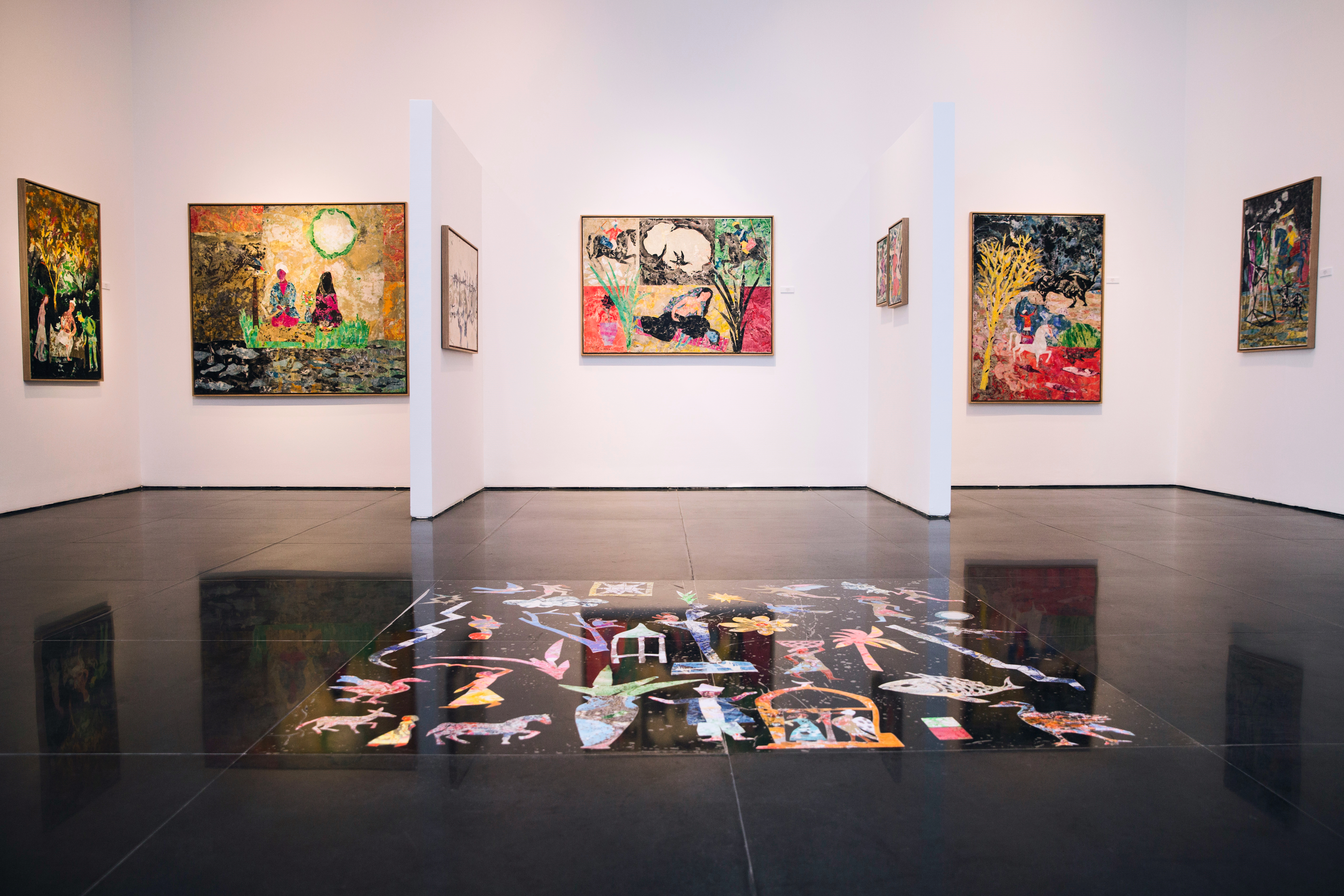
Mohamed Abla’s The Silk Road includes a selection of abstract artworks which synthesise calligraphy, collage and traditional Middle Eastern techniques which explore folktales from North Africa, the Levant, Central Asia and the Indian subcontinent
A common theme in Abla’s work is the exploration of new methods of mark making. For The Silk Road series, the artist employs the Turkish Ebru technique (paper marbling), which is the act of floating paper in a tray filled with water and oil paint. The paint is then carefully transferred to the surface of the paper to create colourful marble-like patterns. Abla cuts shapes from the variously dyed papers, arranging them into compositions resembling animals, heroes, princesses and other folktale figures and imagined scenes derived from the ancient Silk Road network, which was operational from around 120 BCE to 1450s CE.
Narratives play an important role in Abla’s work, and the inspiration for this series stems from the artist‘s research into the history of the Silk Road, as well as recent travels to India, Syria and Iraq. In his works, the artist selects specific folktales which he sees as symbolic of the unsettling political and economic issues in Egypt following the Revolution in 2011. Abla reimagines the activity of the Silk Road through his artwork and draws parallels between past and present politics of the East and West. In another work, The Copper City, Abla chose a Pakistani fairy tale as a point of departure. In the story, all of the inhabitants of a city have been turned into copper except for the princess who is locked in a tower. In a conclusion similar to that of the German fairy tale Rapunzel, a hero rides through the frozen city and saves her. This fable symbolises political and social unrest in many of the countries within the Silk Road network, which paralyse government efforts to address wider problems within their countries.
About Mohamed Abla
1953 Mansoura, Egypt, Mohamed Abla lives and works between Cairo and Fayoum, Egypt and Walsrode, Germany. After graduating from the Faculty of Fine Arts in Alexandria (1973), Abla embarked upon a seven-year journey around Europe, where he visited museums in Spain, France, Belgium and Germany, eventually studying art, sculpture and graphics in Vienna and Zurich.
His first solo exhibition ran at the Hohmann Gallery, Hamburg, Germany (1979), followed by shows at Gallery Ewat, Leeuwarden, The Netherlands (1989); Art Hall, Örebro, Sweden (1991); and the Egyptian Academy of Rome, Italy (1991), amongst others. Later, he moved back to Egypt where he held several solo exhibitions around the country. In 1994 he won the First Prize at the Kuwait Biennial, followed by the Grand Prix at the Alexandria Biennale, Egypt, in 1997. He has also participated in several international art events such as the Havana Biennial, Cuba and his work has been part of several group exhibitions at the Kunstmuseum in Bonn, Germany.
Abla has also founded several artistic institutions which connect artists locally, regionally and internationally through artistic creation. In 2007, Abla founded the Fayoum Art Center, Egypt, where artists meet, work and collaborate. In 2009, he established the first caricature museum in the Middle East, also in Fayoum.
PRAXIS OF CHANGE
An exhibition of works by various artists
22 September – 30 November 2021
Firetti Contemporary, Dubai
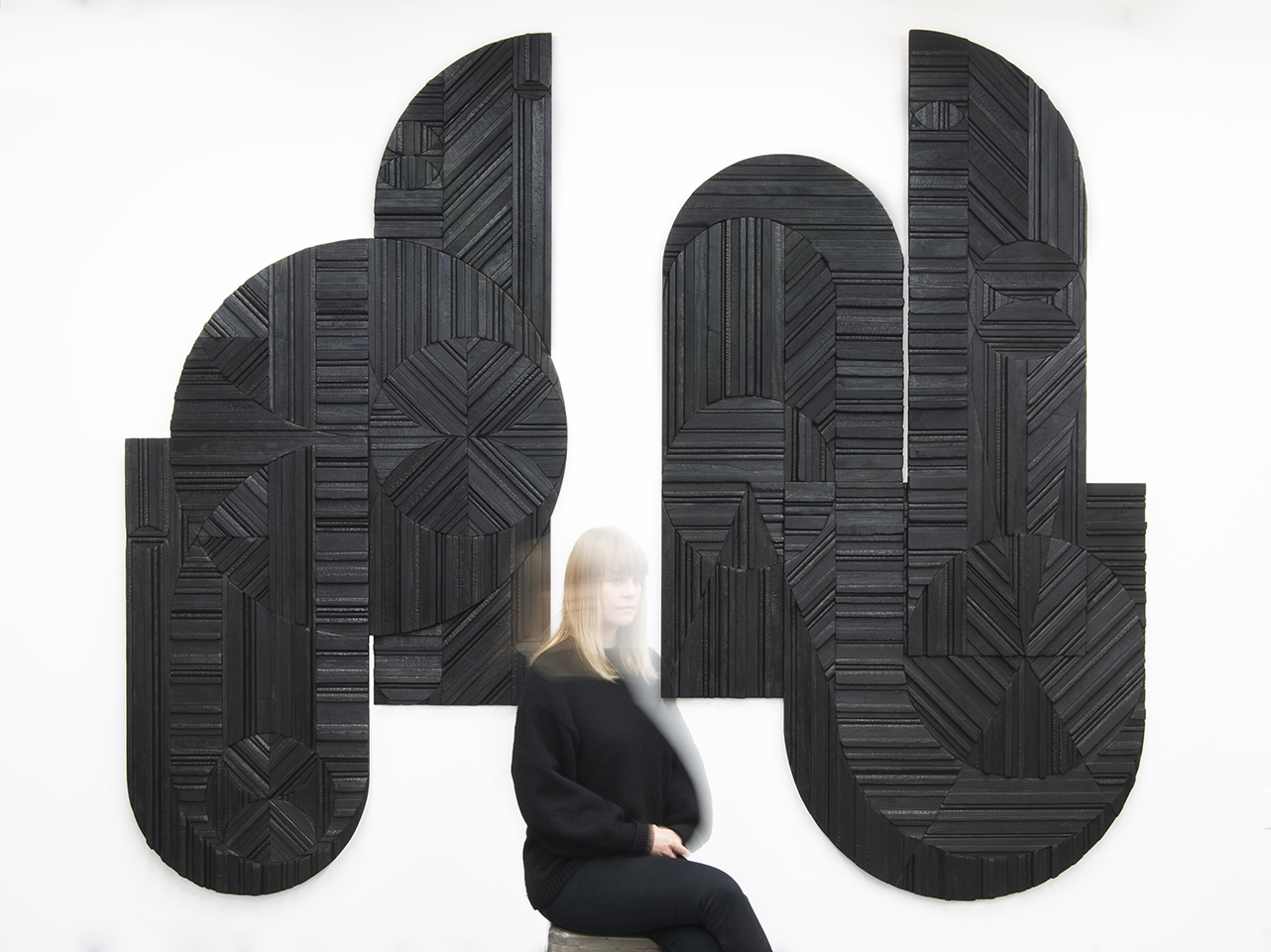




Designed to inspire artistic appreciation and a desire to respond to environmental challenges, the goal of the exhibition is to view art through ecological glasses: How the environment is represented within images and sculptures as well as how the role of humans on Earth is depicted.
There’s a crescendo of interest in both art that is itself in connection with the environment and art that is self-consciously environmental, ultimately drawing attention to anthropogenic global warming. The dialogue between art and our ecological systems surface, where the interconnection of humans and nature can be observed.
Born from the tenacity and hunger to engage with various audiences, the exhibition aims in bringing individuals together outside political affiliation and dive into a different world that allows for more empathy. In conjunction with this passion and desire from artists who grapple with the immensity of environmental degradation, Praxis of Change brings forth the amalgamation of these ideas.
The exhibition is a manifesto stating that saving the planet is a collective effort as well as it demands individual responsibility. Where you are right now and with what you have, there are choices you can make to do your part to save the planet. This is a subject which can be impacted by every single person on Earth. We need to start changing the way we live and focus on a life which aims to help the climate fight, rather than battling against it.
Praxis of Change provides a visual and perceptive insight into the realm of sustainable actions. The impact of intrinsic values is reflected through the well-being of our environment, shedding light on the critical need for a paradigm shift in our current reality. The event falls inline with the core values of Expo 2020 – Connecting Minds and Creating the Future’ through sustainability, mobility and opportunity.
The exhibition showcases the works of 10 different artists, a number that invites a countdown to action and challenges the viewers to implement 10 initiatives towards a more sustainable way of living.
The artists taking part in this exhibition include Charbel Samuel Aoun (Lebanon), Catherine Latson (USA), Laura Lappi (Finland), Rachel Libeskind (USA), Irvin Pascal (UK), Ghizlane Sahli (Morocco), Arjan Shehaj (Albania), Collin Sekajugo (Uganda), Eltjon Valle (Albania) and Fatiha Zemmouri (Morocco)
Helidon Xhixha, IMPRINT
22 March – 20 May 2021
Firetti Contemporary, Dubai

Firetti Contemporary presents a solo exhibition of monumental artworks by international sculptor Helidon Xhixha in occasion of its first opening show.
Two stainless steel sculptures entitled Iceberg and Earth are at the center of the exhibition standing as an astounding manifesto in support of the awareness of Global Warming and the melting of polar glaciers.
An artist whose sculptural practice has gone from strength to strength – Helidon Xhixha’s Iceberg installations convey the intense sense of wonder that characterize his outlook and attitude towards art.
With an approach that is the result of an artistic upbringing, a formal education and the artist’s own instinctive, creative drive, Xhixha presents us with a grand spectacle: Art which challenges its audience. Not simply through its sheer scale and mass but through its engagement with ideas of fundamental importance.
The floating installation ICEBERG by Helidon Xhixha was first exhibited in the middle of the Venetian lagoon in occasion of the 56th Venice Biennale in 2015. A four meter high stainless steel sculpture, captivated audiences, garnering much attention from industry professionals and the media alike; as it floated through the Canal Grande and the Venetian lagoon.
This outstanding reflective sculpture made a statement for global warming and the potential impact it could have on a place such as Venice in the near future.
Luluwah Al Homoud, Beyond the Grid
30 April – 28 June 2018
Tabari Artspace, Dubai

Beyond The Grid by London-based Saudi Arabian artist Lulwah Al Homoud, is composed of a selection of abstract artworks which draw influence from traditional Islamic art, synthesising its characteristic motifs with the regular rhythms of calligraphy and geometry, and ultimately deconstructing them to create a new visual vocabulary.
Amongst the works in the exhibition will be several large-scale minimalist pieces that emulate the geometric forms of Optical Art in bold, singular colouring. Alongside these larger works, Tabari Artspace will show 50 silkscreens from Al Homoud‘s series 99 names of God, displayed as limited-edition bound books.
The works, which originated from the artist’s fascination with written language and Arabic calligraphy, demonstrate a drive to break the rules of traditional Islamic geometric designs in order to create new codes where pattern and word become one.
Al Homoud’s work departs from the idea of numbers representing letters, and the Vedic square, a multiplication system based on a 9×9 grid first developed in North India. In her 9×9 works, Al Homoud incorporates this into her artwork but, instead of the traditional numeric use of 1-9, Homoud has used the first nine stages of the creation of man.
By joining the repeating numbers in the grid, a series of patterns begin to form from which Al Homoud creates her designs, going from multiplicity to unity by using the laws of proportion practiced in traditional Arabic calligraphy. Al Homoud employs a mixture of Islamic and Western mathematics to deconstruct arabic letters and create new codes to compose the 99 names of God, and create a series of new and visually exciting patterns.
As we engage in the dichotomies of existence, the rhetoric between substance, essence and fate compels us into asking what is abstract, what is solid, what is common and what is particular. This discourse moves back and forth between the humanities and the sciences, constantly shedding and reconstructing subtle layers. Arguably, what is most incongruous in this discourse is what is most convergent within it: communication. Using a pure language, this work locks together geometry, faith and beauty, pushing the boundaries of what we know, how we know it and how it is perceived. Lulwah Al Homoud
About Lulwah Al Homoud
Born in Riyadh, Saudi Arabia, Lulwah Al Homoud is based in the United Arab Emirates and London, UK.
Al Homoud completed an MA in Communication Design with a focus on Islamic Art at Central Saint Martins College of Art and Design.
Fascinated by the geometric intricacies of calligraphy, she trained under renowned Pakistani calligrapher Rasheed Butt. Calligraphy is central to Al Homoud’s work, which explores the complexities of linguistic, mathematical and visual systems of communication. Her artistic practice deconstructs Arabic script and applies ancient mathematical principles to devise unique systems of expression, revealed through the elaborate geometric patterns that have become a hallmark of her work. This process reflects Al Homoud’s preoccupation with the relationship between creator and creation, as well as the multifarious ways in which God communicates with man.
Al Homoud is an influential figure in Saudi Arabia, designing the logo and 118 calligraphic wall panels for the Saudi Arabian pavilion at the World Expo in Shanghai, China in 2010. Her work is in collections in international museums including the Los Angeles County Museum of Art (LACMA) in the US, Museum Five Continents in Germany and Jeju Museum in South Korea.
Solo exhibitions include The Dot, Sharjah Art Museum, UAE (2016); Sublime, Naila Art Gallery, Riyadh, Saudi Arabia (2016); Islamic Art Festival, Sharjah Art Museum, UAE (2015); Perpetual Codes, Sharjah Calligraphy Museum (2015); 9×9, Art Space Gallery, Dubai (2014); Ontology, Al Riwaq Art Space, Bahrain (2013).
Khaled Zaki, Resurrection
19 March – 25 April 2018
Tabari Artspace, Dubai

In the exhibition, the artist seeks to capture the essence of his subjects with minimal formal elements, while retaining the integrity of pure white marble. This ethereal colouring suggests a blank canvas from which we may rebuild and start afresh. Each of the sculptures consists of six separate marble components arranged in varying compositions to represent figures in states of fear, defensiveness or repose. The resulting works seem simultaneously modern and ancient, seeking to illicit a diverse emotional response born from the artist’s investigation of the infinite possibilities of the natural form.
Inspired by the fragments of buildings and shrapnel littering the streets in the aftermath of the Egyptian Revolution of 2011 and the Egyptian protests of 2013 as well as the ongoing unsettlement across Egypt, Afghanistan, Iraq and Syria, the artist attempts to symbolically rebuild crumbled societies; to restore order and shape a better future. This is encompassed by the titular concept of rebirth.
Currently based between Cairo and Tuscany, Zaki was born in Suez, Egypt (b. 1964) and has been a key contributor to the development of modernism in Egypt during the second part of the twentieth century. During the early years he studied sculpture and established his use of stone and bronze in the illustrious workshops of Pietrasanta, Italy, a town famous since the 15th century for its carving workshops. Whilst in Italy, Zaki became increasingly inspired by the style and techniques of Italian masters including Michelangelo, Bernini, Canova and Adolfo Wildt. These luminaries of sculpture played an important part in his artistic development and continue to inform his work to this day.
About Khaled Zaki
b. in Suez, Egypt in 1964
Khaled Zaki holds a Masters in Restoration from the Faculty of Archaeology and a Bachelors in Management from the Faculty of Commerce at Cairo University.
Zaki has participated in global exhibitions and biennales, including his Egyptian commission at the 55th international art exhibition of La Biennale di Venezia. His works can be found in the Egyptian Museum for Modern Art, Cairo, the Egyptian Museum for Modern Sculpture, Aswan, and in private collections in Belgium, Germany, USA, Ireland, Italy, Kuwait, KSA, Mexico, and UAE.
Mohamed Abla, The Silk Road
10 October – 24 November 2017
Tabari Artspace, Dubai

Mohamed Abla’s The Silk Road includes a selection of abstract artworks which synthesise calligraphy, collage and traditional Middle Eastern techniques which explore folktales from North Africa, the Levant, Central Asia and the Indian subcontinent
A common theme in Abla’s work is the exploration of new methods of mark making. For The Silk Road series, the artist employs the Turkish Ebru technique (paper marbling), which is the act of floating paper in a tray filled with water and oil paint. The paint is then carefully transferred to the surface of the paper to create colourful marble-like patterns. Abla cuts shapes from the variously dyed papers, arranging them into compositions resembling animals, heroes, princesses and other folktale figures and imagined scenes derived from the ancient Silk Road network, which was operational from around 120 BCE to 1450s CE.
Narratives play an important role in Abla’s work, and the inspiration for this series stems from the artist‘s research into the history of the Silk Road, as well as recent travels to India, Syria and Iraq. In his works, the artist selects specific folktales which he sees as symbolic of the unsettling political and economic issues in Egypt following the Revolution in 2011. Abla reimagines the activity of the Silk Road through his artwork and draws parallels between past and present politics of the East and West. In another work, The Copper City, Abla chose a Pakistani fairy tale as a point of departure. In the story, all of the inhabitants of a city have been turned into copper except for the princess who is locked in a tower. In a conclusion similar to that of the German fairy tale Rapunzel, a hero rides through the frozen city and saves her. This fable symbolises political and social unrest in many of the countries within the Silk Road network, which paralyse government efforts to address wider problems within their countries.
About Mohamed Abla
1953 Mansoura, Egypt, Mohamed Abla lives and works between Cairo and Fayoum, Egypt and Walsrode, Germany. After graduating from the Faculty of Fine Arts in Alexandria (1973), Abla embarked upon a seven-year journey around Europe, where he visited museums in Spain, France, Belgium and Germany, eventually studying art, sculpture and graphics in Vienna and Zurich.
His first solo exhibition ran at the Hohmann Gallery, Hamburg, Germany (1979), followed by shows at Gallery Ewat, Leeuwarden, The Netherlands (1989); Art Hall, Örebro, Sweden (1991); and the Egyptian Academy of Rome, Italy (1991), amongst others. Later, he moved back to Egypt where he held several solo exhibitions around the country. In 1994 he won the First Prize at the Kuwait Biennial, followed by the Grand Prix at the Alexandria Biennale, Egypt, in 1997. He has also participated in several international art events such as the Havana Biennial, Cuba and his work has been part of several group exhibitions at the Kunstmuseum in Bonn, Germany.
Abla has also founded several artistic institutions which connect artists locally, regionally and internationally through artistic creation. In 2007, Abla founded the Fayoum Art Center, Egypt, where artists meet, work and collaborate. In 2009, he established the first caricature museum in the Middle East, also in Fayoum.





